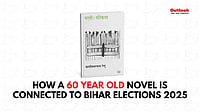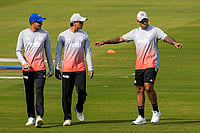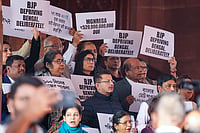The ‘Hindutva’ ideology has taken various shapes and forms across states in India. In Karnataka too, with its sizeable Muslim population, Hindutva forces have existed ever since 1947 but it was only after the 80s that the ideology started to change the social fabric of the state. While the ideology has not had much success in ‘Old Mysuru’ historically, the coastal belt today has become a hotbed for communal tensions and religious politics. Unlike north Indian states, however, Hindutva’s rise in these districts did not take the usual route of majoritarian communalism. Instead, it spread by exploiting existing socio-economic discrepancies and forging strategic social coalitions with both advanced and marginalised groups.
Unlike the rest of Karnataka which, more or less, shows tendencies to be called a ‘cohesive state’ that is tolerant, the coastal belt in the south of Karnataka has been the site for the Hindu Right’s social experiments. Right from the 1980s, the Hindutva that emerged in the coastal belt was strategically placed vis-a-vis other communities. In doing so, it created a political hierarchy with upper caste Brahmins at the top providing the ideological framework or superstructure to the Hindutva narrative. It created an imagined social coalition of 3 Bs—Brahmins, Bunts and Billavas. In northern Karnataka, Hindutva succeeded in forging a social coalition of Lingayats and Brahmins, together known as ‘LIBRA’.
After Brahmins, on the second rung were the Bunts—economically and socially dominant castes in the coastal belt like the Shettys and the Rais. These former feudal lords turned hoteliers, bankers and metropolitan capitalists provided economic backing to the movement. This section provided economical support to the Hindutva politics in the coastal belt in the hope of regaining their lost upper hand.
The third, and perhaps the most important element of this hierarchy is made up of OBCs and Dalits who became the foot soldiers of the Hindutva movement, lured by the promise of political inclusion and upward social mobility. The OBCs who were the product of land reforms that abolished rights of the feudal castes, were undergoing a deep crisis, both culturally and socially. While the reforms gave them economic identity, they continued to face resistance against integration with existing socio-political structures.
This is where Hindutva came in and provided this community in crisis with a promise of liberation and inclusion. Such a process includes a three-step progression: first is to establish the caste identity, the second is to convert that to the Hindu identity. The third and last step is converting the Hindu identity into the Hindutva identity. This social transformation strategy was applied on the ground by fringe groups to mobilise support for Hindutva ideology and bring larger sections under the Hindu fold. Such mobilisation received a fillip with the Ram Janmabhoomi movement and the demolition of Babri Masjid in 1992, which provided a fertile ground for such groups to expand their narratives into the coastal belt of Karnataka.
Why just the coastal parts and not other districts of Karnataka? The answer can be found in socio-economics. In Karnataka, the rise of Hindutva is also a tale of economic competition and historical rivalries. The coastal economy is dominated by a trading community that is largely Muslim—a community that remained critically excluded from the Hindutva hierarchy, albeit being prosperous. Particularly among the Muslims are communities like the Baerys and Navayathi Muslims that are economically strong in the region and whose history dates back to medieval times. In the 1970s and 80s, changes in the middle eastern economy provided them space to grow from petty traders to big entrepreneurs, catapulting them into a mercantile capitalist class. This international trading community also pumped back money which flowed to places like Mangalore which became one of the fastest developing areas in the region.
Interestingly, the feudal-turned-neo-capitalist communities were also making money from the Bombay economy which had started to look up in those pre-liberalisation years, and dominant castes like the Shettys were channeling money from the city into the coastal belt, making it economically prosperous. The cooperative movements that emerged in banking and other sectors also helped the economy grow.
So, in this competitive economic space, Muslims and dominant-caste Hindus managed to find room but the historically oppressed OBCs didn’t. That led to both economic crises and cultural resentment towards Muslims which ‘fringe’ Hindutva groups easily exploited. These groups not only appropriated but also ‘converted’ communities into more ‘Hinduised’ versions through the practice of a ‘politics of celebration’—by celebrating festivals, customs, identity markers, and cultural icons of the OBCs.
In this manner of social conversion, the transformation of the consciousness is key, and fringe organisations managed to do just that by working aggressively on identity creation, be it through the celebration of Nagamandalas (serpent festival) in the aftermath of the 1983 communal riots in the region or the adoption of OBC traditions, cultural symbols, and even icons. This aggressive nature of building identity is essential for pitting OBC communities against Muslims, who have been theorised as the ‘other’. Myths and lies are also used to propagate narratives of hate—for instance, the oft-repeated and wildly fabricated projection of Tipu Sultan as a plunderer who led mass conversions.
While such strategies have helped Hindutva forces grow in coastal Karnataka, it also led to Muslim communalism which is an important factor to understand in the political dynamics of coastal Karnataka. This section became dominant in Mangalore and grew aggressive. The backdrop of growing attacks on Muslims and Hindutva muscle-pumping that led to emergence of militant groups like the Popular Front of India (PFI) which practice their own brand of ‘competitive communalism’. Nevertheless, while the BJP may have support in Karnataka, Hindutva and communal politics continue to thrive only in pockets.
There is also a lot more cultural synergy between Hindus and Muslims in Karnataka than in other states of India. In northern Karnataka, this cultural synergy is very apparent. Hindus celebrate Moharram. Many Muslim communities like the Banjaras celebrate Hindu festivals and even worship Hindu deities. Even in coastal Karnataka where communal tensions are the highest, there is a paradoxical relationship between Hindus and Muslims. While fringe groups and politicians pit them against each other as ideological and political opposites, the two communities remain economically linked.
In Mangalore, the communal divides are very visible: from every home and culvert, flags of two colours denote the two dominant religions. Homes, lamp posts, even trees are being divided. But one also sees Muslim women crowd ice-cream shops owned by Hindus on the weekends while Hindu non-vegetarians buy fish from Muslim sellers. Who controls this economy? Both Hindus and Muslims. The latter have a university, medical and engineering colleges, and hospitals. They also contribute to the growth of the region and the benefits are shared by all.
This economic interdependence is important as it acts as a roadblock for Hindutva. There was an attempt in Mangalore to disrupt the fish market economy, for instance, by encouraging OBC communities to come and sell fish. But it didn’t work.
One of the reasons why fringe organisations fail in ‘Old Mysuru’ is that Hindutva narratives cannot invoke the memories of Partition which are completely absent from the collective consciousness and only come from the textual reading of history. Karnataka doesn’t carry the burden of displacement, refugees, victimisation, rape and loot associated with the event that often shapes Hindutva narratives in the north.
Karnataka also doesn’t have a history of medieval pillage of temples and Hindu structures by invading Muslim armies. While there have been attempts to paint Tipu as a destroyer of temples who led forced conversions, he is widely known and understood to love and stand with Kannadigas.
However, attempts to find such fissures have been evident as can be seen in Hubballi and in the latest emphasis on the ‘Hijab-Halal-Azaan’ strategy to target Muslims and create communal tensions in the run-up to the 2023 assembly elections in the state. This everyday invention of communal strategy to incite communal violence or hate has literally failed to provoke Muslims on an equal footing. However, in Karnataka, social coalitions are the building block of Hindutva’s presence and Hindutva is just one of the many phenomena that have helped the BJP’s rise in the coastal state. The BJP vote bank is not necessarily in support of Hindutva and painting Karnataka in one saffron brushstroke is thus an injustice to the complex socio-politics that will be at play ahead of the coming polls.
(Views expressed are personal)
(This appeared in the print as "An Experiment in Social Coalitions")
Muzaffar Assadi is the Dean, faculty of arts, University of Mysore





















